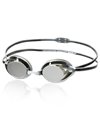 Simple Answer: Swimming goggles fog up because of condensation forming on the inside of the lenses. This is either perspiration or water vapor from your skin. Therefore, it is likely to be worse if you are exerting yourself.
Simple Answer: Swimming goggles fog up because of condensation forming on the inside of the lenses. This is either perspiration or water vapor from your skin. Therefore, it is likely to be worse if you are exerting yourself.More Complicated Answer: The temperature difference (usually colder outside and warm moist air inside) cools the inside air so that the water condenses (ceases to be a gas and becomes a liquid) on the inside of your goggles.
Have you ever noticed that goggles fog less when the air temp and the water temp are close together? If you're swimming in really warm water and you and the air are about the same temp, then you will have less fogging. Or if you are swimming in really cold water and the air temp is close to the same temp, there will be less fogging. (That's why I like colder water swimming in early or late season.)
I've tried about a dozen methods to reduce fogging but never had much luck with any of them. I guess I'm just really hydrated and warm most of the time. Ha!
Simple techniques to stop fogging:
2. Toothpaste: There is liquid soap in toothpaste. (trust me I used to supervise the production of Crest). The same effect as baby shampoo. It's less irritating to the eyes because it's made to be tasteless in the product. Some of the other ingredients may also help such as TiO2 (titanium dioxide) but the silica may scratch your lenses.
4. Use only dry goggles. This reduces the moisture inside the lenses and thus reduces the condensation. You may have noticed that your goggles stay fairly clear when you first put them on but adjusting them or removing them and then replacing them seems to cause fogging to arise more. That's because you have just increased the moisture inside the lenses.
Commercial products to reduce fogging
6. Swim Outlet posted this review of anti-fogging products you might find helpful. And if you want to try any, they sell them too! (great place for a new suit at a good price too)
Hopefully, you can find a solution and if you end up without your commercial anti-fog solution, you'll be able to use one of the simple techniques above. I hope you always have a clear view on your swims and never follow a kayaker off course!
No comments:
Post a Comment